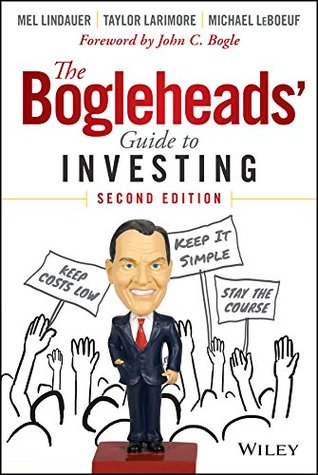More on this book
Community
Kindle Notes & Highlights
Let’s assume someone puts $10,000 in a mutual fund, leaves it there 20 years, and gets an average annual return of 10 percent. If the fund had an expense ratio of 1.5 percent, the fund is worth $49,725 at the end of 20 years. However if the fund had an expense ratio of 0.5 percent, it would be worth $60,858 at the end of 20 years.
Greg Baer and Gary Gensler,
However, if you know nothing about investing, spend minimal time on your investments, and buy index funds, you have a 100 percent chance of being a B investor. In a world where most investors get a D or worse, B is beautiful.
Do not buy load index funds with high annual expense ratios.
He concluded that stock prices are very efficient and that it’s extremely difficult to pick winning stocks after factoring in the costs of transaction fees.
Harry Markowitz is credited with being the father of Modern Portfolio Theory (MPT).
What Are Your Goals?
What Is Your Time Frame?
What Is Your Risk Tolerance?
One of the chief advantages of an asset allocation plan is that it imposes a discipline that will help you to resist the temptation to sell funds in underperforming asset classes and to resist chasing the current “hot” fund.
What Is Your Personal Financial Situation?
“Never buy anything whose price you can’t follow in the newspapers—and you shouldn’t buy anything too complex to explain to the average 12-year-old.”
bonds should equal our age.
Real Estate Investment Trusts (REITs) are a special type of stock. REIT funds often behave differently than other stock funds. This characteristic of noncorrelation can make them a worthwhile addition to larger portfolios. We suggest that REIT funds not exceed 10 percent of your equity allocation.
We also suggest a broad-based, diversified bond fund such as Vanguard’s Total Bond Market Index Fund.
Bonds are primarily for safety.
Taxable high-yield bonds are among the most tax-inefficient of all securities.
High-yield bond funds often have higher returns (and risk)
High-yield bond funds are more closely correlated to stocks.
Treasury Inflation-Protected Securities
Consider adding TIPS(Treasury inflation protected securities) bonds when you portfolio gets bigger(what is bigger?). To add more security and protection. There are 2 types of Vanguard TIPS bonds for this. VIPSX(intermediate-term) and VTAPX(short-term).
VIPSX has 3000 minimum requirement and it has higher return and more risk vs VTAPX has 10000 minimum with less return but lower risk.
PORTFOLIO GUIDELINES
Whenever possible, we will use index funds with their low cost and low turnover. ETFs and low cost, low-turnover, managed funds may also be considered.
Investing is about probabilities—and the probability is good that by using low-cost mutual funds, we will outperform the majority of other investors.


